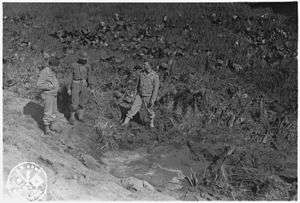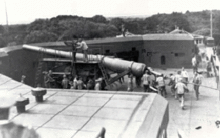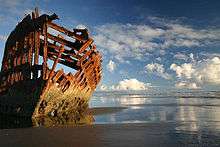Bombardment of Fort Stevens
| Bombardment of Fort Stevens | |||||||
|---|---|---|---|---|---|---|---|
| Part of the American theater and the Pacific Theater of World War II | |||||||
 American service men inspecting a shell crater after the Japanese attack on Fort Stevens. | |||||||
| |||||||
| Belligerents | |||||||
|
|
| ||||||
| Commanders and leaders | |||||||
| unknown | Tagami Meiji | ||||||
| Strength | |||||||
|
Land: 2 artillery pieces 1 fort Air: 1 aircraft | 1 submarine | ||||||
| Casualties and losses | |||||||
| Minor damage | None | ||||||
The Bombardment of Fort Stevens occurred in June 1942, during the American Theater and the Pacific Theater of World War II. An Imperial Japanese submarine fired on Fort Stevens which protected the Oregon side of the Columbia River's Pacific entrance.
Bombardment
The Japanese submarine I-25, under the command of Tagami Meiji, was assigned to destroy enemy ships and engage the enemy on land with their 14 cm deck gun. Also transporting a Yokosuka E14Y seaplane, the submarine was manned by a crew of 97 men.[1] On 21 June 1942, I-25 was in US coastal waters, following allied fishing boats to avoid mine fields in the area.
Late that night, Commander Meiji surfaced his submarine at the mouth of the Columbia River. His target was Fort Stevens, dating back to the American Civil War and armed with obsolete Endicott era artillery, including 12-inch coast defense mortars, and a number of 10 in (250 mm) disappearing guns.[2]
Meiji ordered the deck gun manned and opened fire on Fort Stevens' Battery Russell. The first shots were harmless, in part because the fort's commander ordered an immediate blackout and refused to let his men return fire.[3]
Most rounds struck a nearby baseball field and a swamp, though one landed near Battery Russell and another next to a concrete pillbox. One round severed several large telephone cables, the most significant damage the Japanese caused. Seventeen 5.5 in (140 mm) rounds were fired by the attackers.[4]
American aircraft on a training mission spotted the I-25 and called in an A-29 Hudson bomber to attack. The A-29 found the I-25, but the submarine dodged the bombs and submerged undamaged.[5]
Aftermath


No lives were lost during the encounter. Nevertheless, the attack helped to create the 1942 West Coast invasion scare. Rolls of barbed wire were strung from Point Adams southward in case of an invasion. The wreck of the Peter Iredale was entangled in the wire and would remain so until the war's end.
The Fort Stevens attack was the only time during World War II that a continental United States military installation was attacked by the Axis Powers.[6]

See also
- Bombardment of Madras
- Bombardment of Orleans
- German attacks on Nauru
- Bombardment of Ellwood
- "Battle of Los Angeles"
References
Notes
Bibliography
- Hackett, Bob, and Sander Kingsepp (2002). "HIJMS Submarine I-25: Tabular Record of Movement" (Web page). CombinedFleet.com. Retrieved 2 January 2009.
- Webber, Bert Retaliation Oregon State University Press (1975) ISBN 0-87071-076-1
- Aviation History article
- Fort Stevens. The Coast Defense Study Group, Inc. http://www.cdsg.org/HDCRdata/stevensx.htm. Retrieved on 2008-11-23.
- Fort Stevens State Park. Oregon Parks and Recreation Department http://www.oregonstateparks.org/park_179.php. Retrieved on 2008-11-23.
External links
| Wikimedia Commons has media related to Fort Stevens (Oregon). |
- Fort Stevens State Park, official website from Oregon Parks and Recreation Department
Coordinates: 46°12′7″N 123°57′45″W / 46.20194°N 123.96250°W